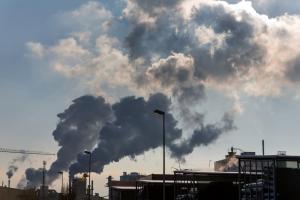
With climate and biodiversity loss heading the news these days, another problem related to the planet we all share is often forgotten: air pollution. Air pollution has an enormous burden on public health, ecosystems, climate, and ultimately, the economy. Globally, the World Health Organization (WHO) estimates that a staggering 7 million deaths are caused by air pollution every single year.
More than 40 years on, the cooperation among Parties to the Convention on Long-range Transboundary Air Pollution (Air Convention) has led to remarkable results: significant emissions reductions (by 30-80% since 1990 in Europe and 30-40% in North America, including particulate matter and sulphur), 1 additional year of life expectancy, and 600,000 lives saved annually. Tackling some pollutants that are bad for air and climate at the same time, the Convention has also supported integrated approaches for clean air and climate action.
However, there are many more challenges still to be tackled to reduce air pollution. A new report on the effectiveness of the Convention’s most recent protocol, the Protocol to Abate Acidification, Eutrophication and Ground-level Ozone or Gothenburg Protocol, shows that, while emission reductions have been achieved, damage to human health, ecosystems and materials remains, showing that the long-term objectives of the protocol - no exceedances of target thresholds that could cause long-term damage to ecosystems and health - cannot be met under current legislation. The report analyses the sufficiency and effectiveness of the Gothenburg Protocol, as amended in 2012, which establishes legally binding emissions reduction commitments for 2020 and beyond for major air pollutants: sulphur dioxide (SO2), nitrogen oxides (NOx), ammonia (NH3), volatile organic compounds (VOCs) and fine particulate matter (PM2.5).
Looking into the future implementation of the protocol, the report also finds that even the most optimistic scenario for 2050, which assumes significant reductions as a result of global climate mitigation policy (including the Global Methane Pledge), and a significant transformation in the agricultural sector, associated with changes in human diet, will still not achieve the long-term objectives of the protocol. This scenario shows that 30 per cent of the population in the region will still be exposed to PM2.5 concentrations above the 2021 WHO guideline level and that, in 25 per cent of the ecosystem area, the nitrogen threshold will be exceeded. The dire consequences for health will be respiratory and cardio-vascular diseases, cancer and premature deaths, while ecosystems will suffer from nutrient overloads, leading, for example, to nitrate pollution and algae blooms in water bodies, with knock-on effects for fish and other species.
More action needed
Since current legislation will not be sufficient to achieve the long-term objectives of the Protocol, the report clearly shows that additional action is needed, particularly in the agricultural sector (NH3 and CH4 (methane as a ground-level ozone precursor)), the energy sector (NOx), road transport (NOx, VOCs, black carbon (BC) and non-exhaust PM), (international) shipping (NOx), solvent use (VOCs), domestic wood burning (PM2.5, BC and VOCs), agricultural residue burning (PM2.5 and BC), gas flaring (BC and CH4) and landfills (CH4). The report also indicates how these additional emission reductions can be achieved: integrated approaches, taking other pollutants and environmental concerns such as climate change, biodiversity loss, energy, transport, agricultural and nitrogen management policies, into account, can offer the most substantial, cost-effective emission reductions.
While technical measures will remain part of the solution to reduce emissions, non-technical and structural measures will also be needed. Special attention for future action needs to be given to methane (CH4) as an ozone precursor, black carbon and ammonia. Methane reduction plays a key role in reaching synergetic effects, as it is both a greenhouse gas and an increasing determinant of ozone formation. Cost-effective technical solutions are available to reduce CH4 from fossil fuel production and waste treatment. To reduce CH4 from the biggest emitting sector in the region -agriculture -policy measures or behavioural change to reduce consumption of meat and dairy could offer synergetic benefits on health, climate, ozone formation and nitrogen pollution.
Clean air is a life and money saver
New research done before the invasion of Ukraine by the Russian Federation in February 2022 on the cost of inaction on air pollution has recently shown that business as usual is not an option as it is up to 25 times more expensive than additional clean air policies. While the average cost of an optimal air pollution strategy is estimated to be 0.01–0.02 per cent of GDP, the current monetary damage cost to health, ecosystems and the economy due to ambient air pollution corresponds to over 5 per cent of GDP in nearly half (26) of 56 countries of the Pan-European region and North America. In at least 6 countries, the damage is more than 10 per cent of GDP. The largest part of the damage cost consists of reduced life expectancy, followed by morbidity costs (e.g., hospital admittance, sick leave, medicine costs), and damage to ecosystems.
This means that greater action on cleaner air pays off by saving lives and money. I call on Finance Ministers to carefully study the findings of this report and mobilize the additional funding needed to achieve cleaner air in the region.
I call on Governments in the UNECE region to redouble ambition to deliver further concrete action to achieve our collective long-term goal to protect ecosystems and human health from air pollution. With political will this is within our reach.

